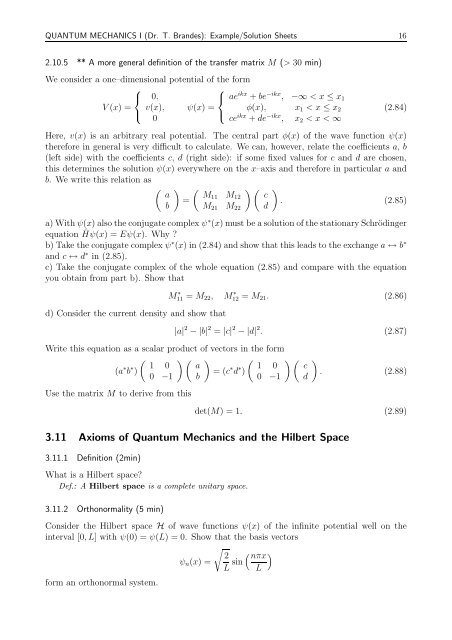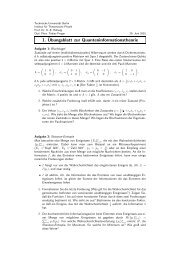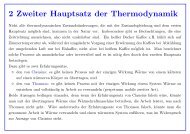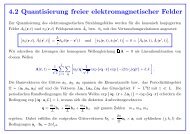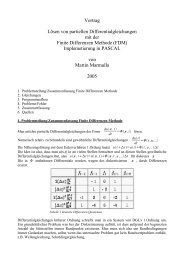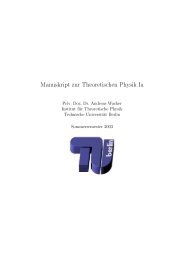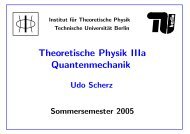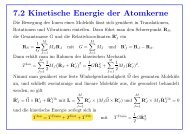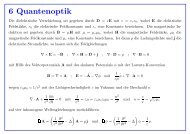1.1 The Radiation Laws and the Birth of Quantum Mechanics
1.1 The Radiation Laws and the Birth of Quantum Mechanics
1.1 The Radiation Laws and the Birth of Quantum Mechanics
You also want an ePaper? Increase the reach of your titles
YUMPU automatically turns print PDFs into web optimized ePapers that Google loves.
QUANTUM MECHANICS I (Dr. T. Br<strong>and</strong>es): Example/Solution Sheets 16<br />
2.10.5 ** A more general definition <strong>of</strong> <strong>the</strong> transfer matrix M (> 30 min)<br />
We consider a one–dimensional potential <strong>of</strong> <strong>the</strong> form<br />
⎧<br />
⎧<br />
⎨ 0,<br />
⎨ ae ikx + be −ikx , −∞ < x ≤ x 1<br />
V (x) = v(x), ψ(x) = φ(x), x 1 < x ≤ x 2<br />
⎩<br />
⎩<br />
0<br />
ce ikx + de −ikx , x 2 < x < ∞<br />
(2.84)<br />
Here, v(x) is an arbitrary real potential. <strong>The</strong> central part φ(x) <strong>of</strong> <strong>the</strong> wave function ψ(x)<br />
<strong>the</strong>refore in general is very difficult to calculate. We can, however, relate <strong>the</strong> coefficients a, b<br />
(left side) with <strong>the</strong> coefficients c, d (right side): if some fixed values for c <strong>and</strong> d are chosen,<br />
this determines <strong>the</strong> solution ψ(x) everywhere on <strong>the</strong> x–axis <strong>and</strong> <strong>the</strong>refore in particular a <strong>and</strong><br />
b. We write this relation as<br />
(<br />
a<br />
b<br />
) ( ) (<br />
M11 M<br />
=<br />
12 c<br />
M 22 d<br />
M 21<br />
)<br />
. (2.85)<br />
a) With ψ(x) also <strong>the</strong> conjugate complex ψ ∗ (x) must be a solution <strong>of</strong> <strong>the</strong> stationary Schrödinger<br />
equation Ĥψ(x) = Eψ(x). Why <br />
b) Take <strong>the</strong> conjugate complex ψ ∗ (x) in (2.84) <strong>and</strong> show that this leads to <strong>the</strong> exchange a ↔ b ∗<br />
<strong>and</strong> c ↔ d ∗ in (2.85).<br />
c) Take <strong>the</strong> conjugate complex <strong>of</strong> <strong>the</strong> whole equation (2.85) <strong>and</strong> compare with <strong>the</strong> equation<br />
you obtain from part b). Show that<br />
d) Consider <strong>the</strong> current density <strong>and</strong> show that<br />
M ∗ 11 = M 22 , M ∗ 12 = M 21 . (2.86)<br />
|a| 2 − |b| 2 = |c| 2 − |d| 2 . (2.87)<br />
Write this equation as a scalar product <strong>of</strong> vectors in <strong>the</strong> form<br />
( ) ( ) ( ) (<br />
1 0 a 1 0 c<br />
(a ∗ b ∗ )<br />
= (c ∗ d ∗ )<br />
0 −1 b<br />
0 −1 d<br />
Use <strong>the</strong> matrix M to derive from this<br />
)<br />
. (2.88)<br />
det(M) = 1. (2.89)<br />
3.11 Axioms <strong>of</strong> <strong>Quantum</strong> <strong>Mechanics</strong> <strong>and</strong> <strong>the</strong> Hilbert Space<br />
3.1<strong>1.1</strong> Definition (2min)<br />
What is a Hilbert space<br />
Def.: A Hilbert space is a complete unitary space.<br />
3.11.2 Orthonormality (5 min)<br />
Consider <strong>the</strong> Hilbert space H <strong>of</strong> wave functions ψ(x) <strong>of</strong> <strong>the</strong> infinite potential well on <strong>the</strong><br />
interval [0, L] with ψ(0) = ψ(L) = 0. Show that <strong>the</strong> basis vectors<br />
√<br />
2<br />
( nπx<br />
)<br />
ψ n (x) =<br />
L sin L<br />
form an orthonormal system.


